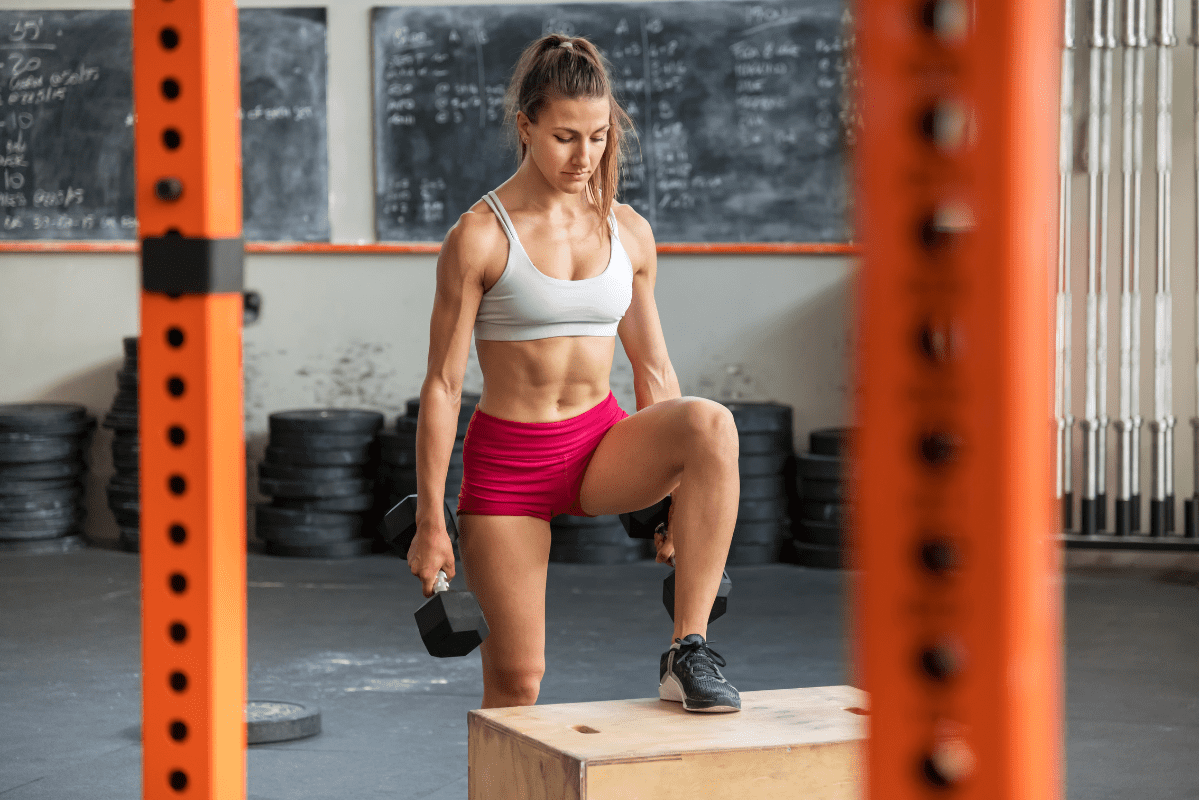8 Dumbbell Step-Up Alternatives For Single-Leg Strength
Dumbbell Step-Ups are an excellent single-leg exercise. They’re both beginner-friendly and yet still can be challenging to advanced lifters.
However, sometimes you may need an alternative for Dumbbell Step-ups.
You may not have dumbbells or a sturdy box to use or maybe you’re just looking to add some variety to your workout.
Good news, you’re in the right place. I’m about to share with you 8 of my favorite alternative exercises for Dumbbell Step-Ups.
Best Dumbbell Step-Up Alternatives
I’ve tried to make this list of alternatives as diverse as possible. There are exercises that use a barbell, dumbbells or no equipment at all. Hopefully, no matter what equipment you have or what your lifting experience is – one of these alternatives can serve as a replacement for Dumbbell Step-Ups.
Single Leg Squat off Box
Equipment Needed
- An extremely stable box or bench
- A partner who will hold down the side of the box if needed as a counterweight.
Step-by-Step Instructions
- Stand tall with one leg down and the other straight drifting off the side of the box.
- Initiate the squat by hinging at the waist and bending at the knee simultaneously.
- Descend until the hip crease is just below the knee.
- Keep the heel flat and the center of mass over the mid-foot.
- Keep the torso as vertical as possible. Sometimes holding the arms straight out from here will help with balance and torso positioning.
- Once you reach depth, drive through the heel, keeping the foot flat, and stand tall.
Coaching Points
Single Leg Squats off a Box are by far one of the most difficult variations of single-leg training. A proper progression needs to be followed in order to prepare the athlete for a movement like this.
Skater Squats
Equipment Needed
- None
Instructions
- Squeeze the shoulder blades and engage the lats to create a stable back to help with bracing the upper body
- Step backward with one leg, but do not place the foot back down on the ground.
- Instead, keep the chest as upright as possible and drop the back knee until it lightly touches the ground.
- Now drive through the heel and midfoot of the front foot to drive yourself back up tall.
- Repeat on the opposite leg and alternate back and forth until all reps have been completed.
Coaching Points (Fixes to Common Mistakes)
Keep the front foot flat on the floor when in the lunge position. One of the most common mistakes is raising up onto the ball of the front foot.
If you’re not able to do Skater Squats with good form, switch to a regular Reverse Lunge until you’re ready to do Skater Squats with proper form.
Bulgarian Split Squat
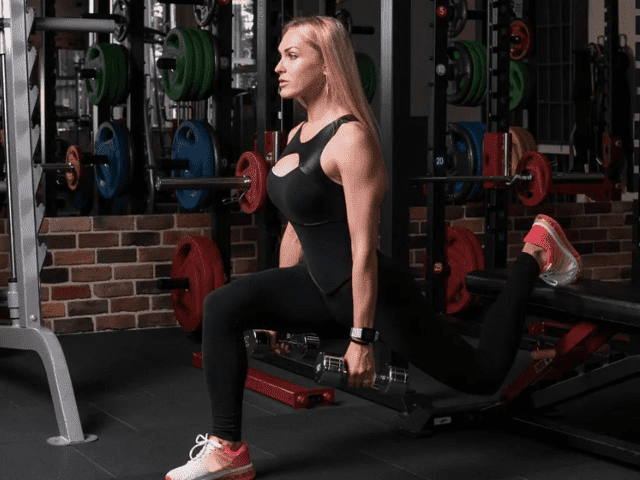
Bulgarian Split Squats are one of my favorite Dumbbell Step-ups alternative exercises. A Bulgarian Split Squat isolates the front leg and can also help improve balance and coordination.
Equipment Needed
- Dumbbells
- Bench, Box or Stack of Bumper Plates (essentially anything stable enough and tall enough to place your foot on)
Instructions
- Grab two dumbbells, one in each hand
- Get set up in front of your bench, reach one foot back and place it on the bench. Make sure you feel comfortable and balanced before proceeding.
- Squeeze the shoulder blades and engage the lats to create a stable back to help with bracing the upper body and to keep the dumbbells from swinging unnecessarily.
- Keep the chest as upright as possible and drop the back knee to roughly one inch from the floor.
- Now drive through the heel and midfoot of the front foot to drive yourself back up tall.
- Repeat until all reps are completed on that leg and then switch sides.
Coaching Points (Fixes to Common Mistakes)
When you step out, make sure to keep the feet shoulder-width apart. If you’re feeling very off-balance with Bulgarian Split Squats there is a good chance that you are placing the lead foot directly in front of the back foot (essentially placing yourself on a tight rope).
Barbell Reverse Lunge
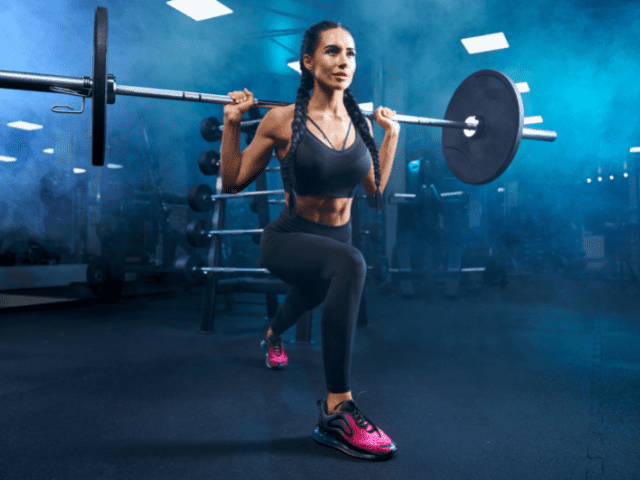
Equipment Needed
- Barbell
- Bumper Plates (Iron Plates are fine as long as you’re not dropping the bar between sets)
- Squat Rack (Not completely necessary as you can clean and press a bar onto shoulders if needed, but a rack is going to make this a whole lot easier, especially if lifting heavier weight)
Instructions
- Unrack the barbell similar to how you would unrack a bar for a back squat.
- Grab the bar with a slightly wider than shoulder-width grip.
- Squeeze the shoulder blades and engage the lats to create a stable shelf to sit the bar on
- Place the bar across the traps, brace the core and remove the bar from the rack by standing tall and then walking back out of the rack.
- Once you’ve created enough room for yourself from the rack you can begin the movement.
- Step backward with one leg, giving yourself enough room to be able to drop into a lunge comfortably without feeling overextended.
- Keep the chest as upright as possible and drop the back knee to roughly one inch from the floor.
- Now drive through the heel and midfoot of the front foot to drive yourself back up tall.
- Repeat on the opposite leg and alternate back and forth until all reps have been completed.
Coaching Points
When you step back, make sure to keep the feet shoulder-width apart. If you’re feeling very off-balance with Barbell Reverse Lunge there is a good chance that you are stepping the lead foot directly behind the front foot (essentially placing yourself on a tight rope).
Dumbbell Lunge
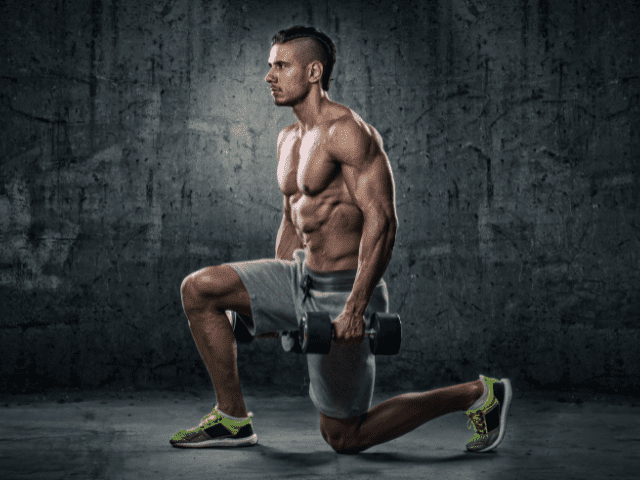
Whether it’s lunges in place or walking lunges, Dumbbell Lunges are a classic lower-body movement that can serve as a quality replacement for Step-Ups.
Equipment Needed
- Dumbbells
Instructions
- Grab two dumbbells, one in each hand
- Squeeze the shoulder blades and engage the lats to create a stable back to help with bracing the upper body
- Once you’ve created enough room for yourself from the dumbbell rack (or wherever you pulled them from) you can begin the movement.
- Step forward with one leg, giving yourself enough room to be able to drop into a lunge comfortably without feeling overextended.
- Keep the chest as upright as possible and drop the back knee to roughly one inch from the floor.
- Now drive through the heel and midfoot of the front foot to drive yourself back up tall.
- Repeat on the opposite leg and alternate back and forth until all reps have been completed.
Coaching Points (Fixes to Common Mistakes)
When you step out, make sure to keep the feet shoulder-width apart. If you’re feeling very off-balance with Dumbbell Lunges there is a good chance that you are stepping the lead foot directly in front of the back foot (essentially placing yourself on a tight rope).
Pistol Squats
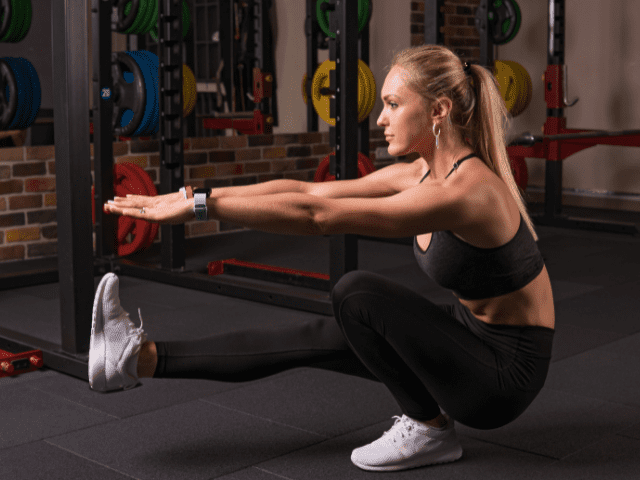
Equipment Needed
- None (If doing a modified Pistol Squat a box or bench to squat to will be needed)
Instructions
On Air
- Stand on one leg with the opposite leg straight and slightly out in front of the body.
- Squat down on the single leg by hinging back at the hips first and then bending the knee and hips until the crease of the hip crosses below the knee.
- Keep the heel flat and your weight distributed between your heel and mid-foot.
- Keep your torso as vertical as possible while maintaining balance and a flat foot.
- The opposite leg should stay straight and extend out in front of you as you squat down (tight hamstrings will make this almost impossible!)
- Once you reach the bottom of the squat, drive the foot through the floor and stand tall.
To Box
- Instructions are the same as above, except the athlete will squat down to a box (or bench) instead of freely in an open space.
- Make sure the foot is close enough to the box so that the box is not missed when squatting down to touch it. (I’ve seen it happen)
- Control the descent to the box and sit as softly as possible. A light touch-and-go is ideal if possible. My favorite cue for this was to “treat the box like a glass coffee table.”
Coaching Points
If you’re not able to do a Pistol Squat the first time trying, don’t worry, you’re not alone. Most athletes I’ve worked with have to start by using a bench for pistol squats. The first thing you need to do to start progressing is figuring out where your real weakness is: strength or flexibility.
Some lifters simply don’t possess the strength at first to perform a full pistol squat on air. On the other hand, many of the athletes I’ve coached actually have the strength to do a pistol squat, but they lack the mobility to be able to go through the full range of motion without falling or their opposite foot crashing into the ground.
Figuring out where to focus your energy is the first step toward improving your Pistol Squat.
Single Leg Leg Press
To be honest, I’m not a huge fan of the leg press machine. I believe there are countless other leg exercises that carry more benefits.
However, if an athlete has an injury to one leg that limits them in the weight room – this is a situation in which we’ll use the leg press for Single Leg Leg Press. (Even though Pistol Squats are also a single-leg exercise, balance can become an issue and you want to avoid stepping down to brace with the opposite leg)
How you’ll set up for Single Leg Leg Press is very dependent on your specific machine. Leg Presses can vary quite a bit in how they’re setup and how they’re used.
What I will say is to start very light. Make sure you’re comfortable with the range of motion and comfortable with the amount of weight you’re using before you start increasing weight.
Prowler Push
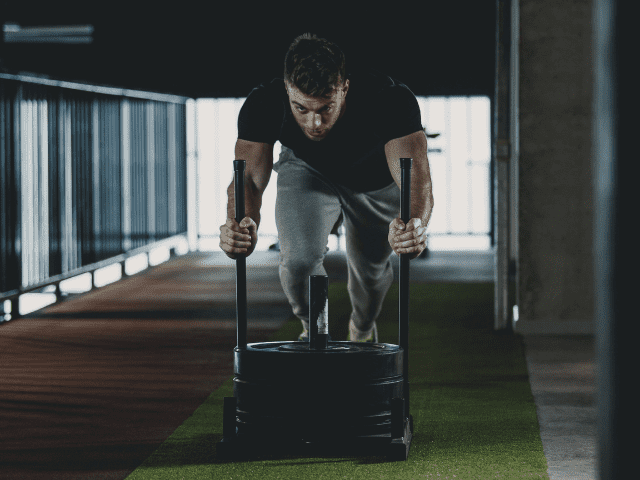
Equipment Needed
- Prowler sled
- Bumper or iron plates
- At least a 20-yard stretch of turf
- Proper footwear. Shoes with a good grip or cleats (if turf is available) are ideal.
Step-By-Step Instruction
- Set your prowler in an area where you can push it at least 20 yards without hitting anything.
- Load the prowler with weight.
- Get behind the prowler and grab the high handle position.
- Hinge at the waist, bend the knees and extend your arms.
- Drive your legs and push the sled forward.
Coaching Points
The Prowler Push is a full-body movement. Keep the core tight, nice neutral spine, and keep those arms extended (Arms can be bent when focusing on heavier loads).
Focus on a strong knee drive and pushing through your feet to keep the prowler moving. Your body angle will be very similar to how you start a sprint. So the lower body action should be very similar to running.
A very important consideration here is the surface you are pushing on. Ideally, you are pushing the prowler on turf. This gives enough surface tension so that the prowler doesn’t glide or get stuck too easily. If you are pushing on a slicker surface like concrete or carpet, you may have to load more weight on the sled.
Final Thoughts
Dumbbell Step-Ups are an amazing exercise and one of my favorite single-leg movements. However, I also understand that there are situations where you simply can’t do Dumbbell Step-ups.
Hopefully, this list has helped you figure out a different movement that you can use as a substitute.
Finally, you should never let lack of equipment stop you from being able to get a great workout in. If you’re a little creative, there is always a way to make it happen. For example, here are 10 trap bar deadlift alternatives if you don’t have a trap bar.

